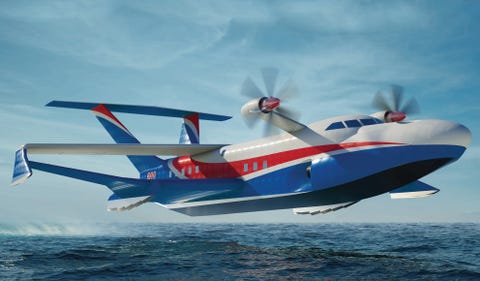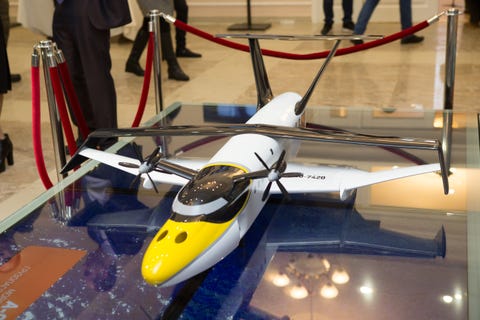Russia Developing a New Air-Riding 'Sea Monster'
The Orlan wing-in-ground-effect vehicle would be a ship-aircraft hybrid that hugs the surface of water.
By Kyle Mizokami ALEKSEYEV CENTRAL HYDROFOIL DESIGN BUREAU
ALEKSEYEV CENTRAL HYDROFOIL DESIGN BUREAURussia is reportedly developing a new generation of wing-in-ground-effect vehicles inspired by monster craft developed during the Cold War. The new Orlan craft will be a descendant of the so-called 'Caspian Sea Monster,' a now defunct vehicle that flew across wavetops at speeds of up to 400 mph.
Russian State Media reports that the Orlan, currently under development, will be ready by 2027. “The state armament program for 2018-2027 includes the Orlan research and development work, which stipulates the construction of the wing-in-ground-effect craft. The prototype will be created as part of this armament program and it will carry missile armament,” Russian Deputy Prime Minister Yuri Borisov told the TASS news agency.
Wing-in-ground-effect craft are designed to operate above the surface of the water on a cushion of air the provides aerodynamic lift. They function sort of like hovercraft, but generate lift through the use of large, glider-like wings. The large, seagull-like craft can also travel faster, at speeds of up to 250 to 350 miles an hour.
The Soviet Union built several types of ground-effect vehicles, including the Lun, or “Caspian Sea Monster,” which was 240 feet long, 63 feet tall, and had a wingspan of 144 feet. The “Sea Monster” weighed 550 tons and flew to ranges of up to 1,080 nautical miles. It flew just 16 feet above the ground, could carry a cargo of Soviet marines, and was armed with six P-270 Moskit anti-ship missiles. Built in 1966, the “Monster” flew for fourteen years before sinking 1980.

A model of the "Chiaka 2 wing in ground effect vehicle" by the Alekseyev Central Hydrofoil Design Bureau.
ALEKSEYEV CENTRAL HYDROFOIL DESIGN BUREAU.
The Soviet Union was inspired to build ground-effect craft due to their utility on inland seas and restricted waterways—something the Soviets and now Russians have plenty of. These sorts of vehicles are useful in the Caspian Sea, Black Sea, the Barents and probably the Sea of Okhotsk.
According to TASS, the new Orlan will be used to, “protect the Northern Sea Route where infrastructure is weakly protected.” The vehicle will also be used for search and rescue, and like the Lun class will also have missile armament. The size and performance characteristics are unknown but TASS also quoted the head of Russian Naval Aviation as saying he expected a vehicle with carrying capacity of 300 tons by 2020—likely the Orlan, delayed. This puts the new craft in “Sea Monster” territory. Russia teased a smaller design, the Chiaka A-050, in 2017.
The Orlan craft is currently under development by the Alekseyev Central Hydrofoil Design Bureau, based in Nizhniy Novgorod, Russia.
No comments:
Post a Comment